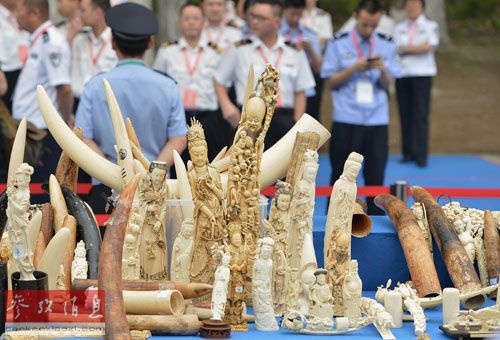US media: China cracks down on ivory trade effectively threatened sculpture students gauge ivory | | | sculpture _ the animal protection news
 Illegal ivory and ivory products to be destroyed. Xinhua News Agency reporter Maggie Lee photography
Illegal ivory and ivory products to be destroyed. Xinhua News Agency reporter Maggie Lee photography Reference news, March 20 us media said Li Chunke 1964 began working in the ivory carving, at that time still in the upward trend in the number of elephants in Africa. There is little demand for ivory in China at that time, buy a kg of ivory for under $ 7. But according to published reports said save the elephants, ivory prices have nearly $ 1100 today.
According to the United States cable news network, March 13, though Li Chunke ivory prices soaring in the career, but in the past 18 months, ivory prices falling by almost half.
Reported that the environmentalists for the recent decline in demand for ivory, they attributed this awareness of animal protection plan, and China is committed to clear the territory of ivory trade. But it seems to Li Chunke, 65 years old, this change in the attitude of an ancient art form as well as sculptors poses a threat to livelihoods.
Li Chunke sipping green tea in the small apartment in Beijing said: "ivory is representative of traditional Chinese culture. Chinese ivory carving, because this is one of the oldest craft, ivory belonging to the Royal College of art. ”
Reports said Li Chunke in 50 years in a State-owned factory, from small ornaments to decorate with classic beauty the whole tusks, and his sculpture works is everything. But legal restrictions meant he was now at home and save the original ivory.
However, Li Chunke far side of the living room, still has a small Studio inside many chisels, drills and other tools. Some tools are power, but most of the tools are simple hand tools.
He singled out a few from a bunch of stuff by carving small sculptures in various materials. Ivory is valuable because of its high density and the surface is smooth, it is the ideal raw material for carving process. But there are other choices. Hippo, walrus and narwhal tusks has similar qualities.
Li Chunke explains: "when there is no ivory, we use beeswax and agarwood. ”
Li Chunke shows a small horse sculpture and an ancient statue, which was carved out of mammoth ivory. Mammoth ivory is excavated from the Siberian permafrost, and can be used as substitute for ivory.
Li Chunke recalls "(60 's of last century) we are making many carvings are exported to foreign countries, the sculpture must reflect the traditional culture of China. Now, I can engrave works on various topics, including the themes of modern life. ”
According to Li Chunke estimates, since 2013 retired from the factory, he carved works less than 10 each year, carving a piece long takes two months.
Reports said Li Chunke poaching, as well as black market associated with the ivory carving industry seems to be upset. He said: "we are legitimate professional ivory carvers. We use ivory from natural deaths of elephants. We should protect the wildlife. I love animals, I have a pet dog. I am shocked by human hunting of elephants. ”
1989 ivory ban enacted throughout the world, but like the factory where Li Chunke manufacturers can continue to operate, because China is still allowed in domestic trading in ivory. Licensing systems continue to be allowed to import from the natural death of the elephant tusks or ivory confiscated by the police.
A former basketball star Yao Ming will be the endorsement of animal protection campaigns notes that ivory-ivory trade of consumption--even with permission – contributes to this vicious cycle of killing.
Li Chunke said, "Yao said ' no sale, no killing ', this is only partly right. We have to think how to inherit Chinese traditional culture. Of course, raw materials can be replaced by something else, which is the reason why my students are using wood and jade. However, some carved on ivory only show such a process is at risk. ”
In the center of Beijing on the other side, Li Chunke 26 year old student Li Jiulong and four other apprentices share this Studio. A sculptor sitting in practice carving a small piece of wood.
While his master is older, do not have to care about the problem of the declining demand for ivory, but Lee had a much smaller legs. Apart from the apprentice, and Li Jiulong still learning the painting process.
Li Jiulong through "proper channels" for ivory, but he will spend most of their time in the carving on other materials, such as mammoth ivory. He explained: "the mammoth tusks buried underground for a long time, so there may be cracks, color may change. ”
Reports that since 2000, imports from Hong Kong has increased by more than twice the number of mammoth ivory. But the young sculptor was to have some hope in ivory, although demand for ivory has recently dropped.
Li Jiulong, said: "Indeed, the ivory trade will not be big business in the future, but it will not become extinct. This, after all, is an integral part of our traditional culture. Ivory carving will be passed along, also retain their status. "(Compilation/Wang Chao)
Responsible editor: Liu Debin SN222
Article keywords:Ivory carved animal protection
I want feedback
Save a Web page
Reference news network
美媒:中国打击象牙买卖显成效 威胁雕刻师生计|象牙|动物保护|雕刻_新闻资讯
 将被销毁的非法象牙及象牙制品。新华社记者 李鑫 摄
将被销毁的非法象牙及象牙制品。新华社记者 李鑫 摄 参考消息网3月20日报道 美媒称,李春珂1964年开始从事象牙雕刻,当时非洲大象的数量还处于上升势头。当时中国对象牙几乎没有什么需求,买一公斤象牙还不到7美元。但据拯救大象组织公布的研究报告称,如今的象牙价格已接近1100美元。
据美国有线电视新闻网网站3月13日报道,虽说在李春珂的职业生涯中象牙价格出现暴涨,但过去18个月里,象牙价格几乎跌去了一半。
报道称,环保主义者对近来象牙需求量下降表示肯定,他们将此归功于提高动物保护意识的计划以及中国致力于清除境内的象牙交易。但在现年65岁的李春珂看来,这种态度上的转变对一种古老的艺术形式以及雕刻师们的生计都构成了威胁。
李春珂在北京的小公寓里一边喝着绿茶一边说:“象牙雕刻是中国传统文化的代表。中国人喜欢象牙雕刻,因为这是一种古老的工艺,象牙雕刻属于皇家艺术范畴。”
报道称,李春珂在国有工厂里干了50年,从小装饰品到用古代经典美景装饰整根象牙,他雕刻的作品可谓无所不包。但法律上的限制意味着,他现在很难在家里保存原始象牙了。
尽管如此,在李春珂家客厅的远侧,仍然有一个小工作室,里面摆着很多凿子、钻头及其他工具。有些工具是电动的,但大多数工具都是简单的手工工具。
他从一堆东西中挑出了几件用各种材料雕制的小雕塑。象牙的珍贵之处在于其密度高且表面光滑,它是进行精雕工艺的理想原材料。但目前还有其他一些选择。河马、独角鲸和海象的长牙也具有类似特质。
李春珂解释说:“没有象牙的时候,我们也使用蜂蜡和沉香木。”
李春珂展示了一个小马雕塑和一个古代神仙雕像,它们是用猛犸象牙雕刻而成的。猛犸象牙是从西伯利亚永久冻结带挖掘出来的,可作象牙的替代品。
李春珂回忆道:“(上世纪60年代)我们制作的很多雕刻品都出口到国外了,那些雕刻品必须体现中国的传统文化。如今,我可以雕刻各种主题的作品,其中包括现代生活主题。”
据李春珂估算,自从2013年从厂子里退休以来,他每年雕刻的作品不足10件,雕刻一件作品最长耗时两个月时间。
报道称,李春珂对偷猎大象的行为以及与象牙雕刻产业有关的黑市似乎感到很沮丧。他说:“我们都是合法的专业象牙雕刻师。我们使用的象牙都取自自然死亡的大象。我们应该保护野生动物。我喜欢动物,我还养了一只宠物狗。人类猎杀大象令我感到震惊。”
1989年全世界针对象牙颁布了禁令,但像李春珂所在的工厂这样的厂家仍然可以继续经营,因为中国目前仍允许在国内从事象牙交易。有项许可证制度允许继续进口取自自然死亡的大象的象牙或警方没收的象牙。
一个由前篮球明星姚明做代言的动物保护宣传运动指出,象牙消费——即便是有许可的象牙交易——助长了这一充满杀戮的恶性循环。
李春珂说:“姚明说‘没有买卖就没有杀害’,这只说对了一部分。我们还得思考如何传承中国的传统文化。当然,原材料可以用别的东西代替,这就是我的学生也使用木材和翡翠的原因。但有些精雕细刻只能在象牙上表现出来,这样的工艺就有危险了。”
在北京市中心的另一侧,李春珂26岁的学生李九龙和其他四名学徒共用这间工作室。一名雕刻师在坐着练习雕刻一小块木头。
虽说他的师父已上了年纪,不必去在乎象牙需求量不断下滑的问题,但小李必须多条腿走路。除学徒外,李九龙还在学习涂漆工艺。
李九龙可以通过“正当途径”获得象牙,但他还是将大部分时间都用在了雕刻其他材料上,如猛犸象牙。他解释说:“猛犸象牙在地底下埋了很长时间,因此可能有裂痕,颜色也可能有变。”
报道称,自2000年以来,从香港进口猛犸象牙的数量已经增长了两倍多。但这位年轻的雕刻师还是对象牙雕刻抱有一些希望,尽管象牙的需求量最近出现了下滑。
李九龙说:“确实,象牙交易今后不会是规模很大的生意了,但也不会灭绝。这毕竟是我们传统文化的一个组成部分。象牙雕刻工艺会传承下去,也会保住自身的地位。” (编译/王超)
责任编辑:刘德宾 SN222
文章关键词: 象牙 动物保护 雕刻
我要反馈
保存网页
参考消息网